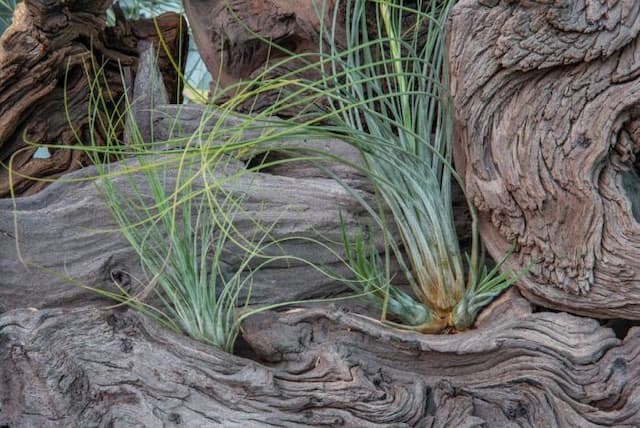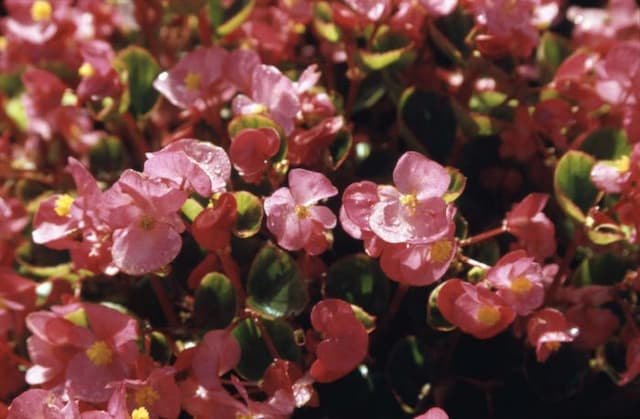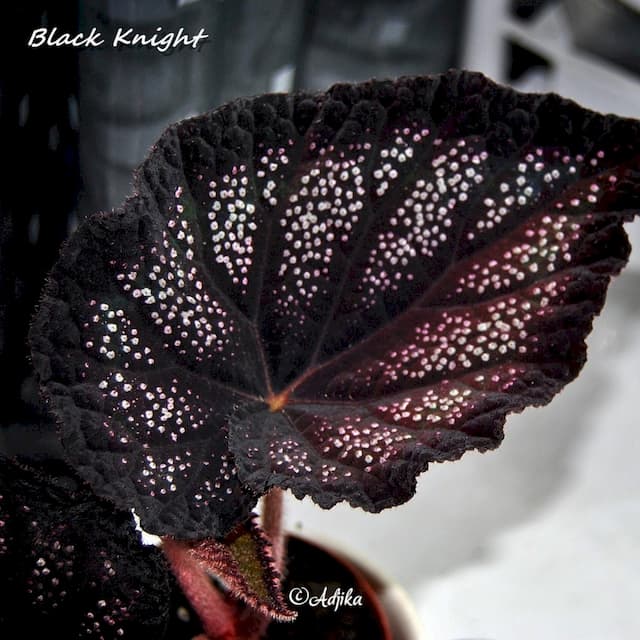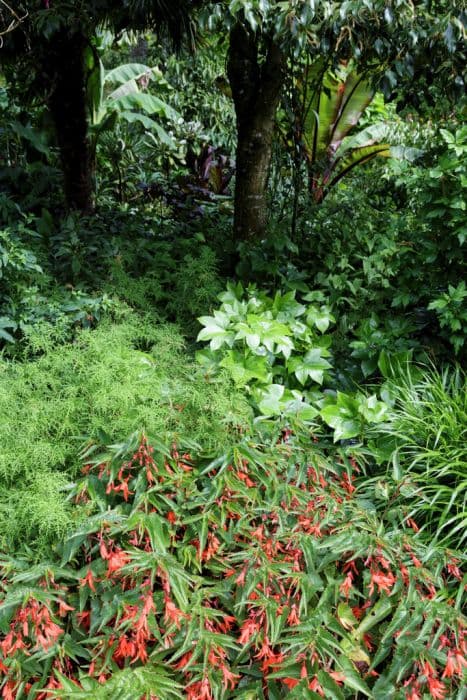Thurston's begonia Begonia 'Thurstonii'

ABOUT
Begonia 'Thurstonii' is an ornamental plant known for its stunning foliage and showy flowers. The leaves are a striking feature, boasting a glossy and hearty texture. Their color gradient is impressive, starting with a deep green at the center which transitions to a burgundy or reddish hue towards the edges. This combination gives the leaves a rich, iridescent look, sometimes with a metallic sheen. The undersides of the leaves shouldn't be ignored as they are a vibrant reddish-pink, adding to the plant's dramatic flare. This color palette makes it stand out amongst other plants in any garden or indoor space. The leaf shape is another beautiful aspect, with a broad and heart-like form tapering to a subtle point. Throughout the blooming season, the Begonia 'Thurstonii' produces clusters of flowers that stand out against the foliage. The blossoms are delicate and can range in color, often exhibiting shades of soft pink or white. These flowers add a touch of gracefulness to the plant, making it a favorite among gardeners and houseplant enthusiasts. The combination of its vivid leaves and graceful flowers makes the Begonia 'Thurstonii' a visually captivating plant that can serve as an excellent ornamental addition to both outdoor gardens and indoor spaces.
About this plant
 Names
NamesSynonyms
Thurston Begonia, Thurston's Begonia, Thurstons Begonia
Common names
Begonia 'Thurstonii'
 Toxicity
ToxicityTo humans
Begonia 'Thurstonii', commonly known as Thurston Begonia, is considered non-toxic to humans. However, like many begonias, it can cause irritation to the skin or mouth due to its sap containing irritant compounds such as calcium oxalate crystals. If ingested, the plant may cause discomfort in the mouth, lips, throat, and tongue due to the irritating nature of these crystals. In rare cases, this may lead to nausea, vomiting, or diarrhea if eaten in significant quantities.
To pets
Thurston Begonia is toxic to pets, including dogs and cats. If a pet ingests this plant, it may experience symptoms such as drooling, vomiting, diarrhea, and a decrease in appetite due to the irritation caused by the calcium oxalate crystals found in the plant's tissue. In severe cases, ingestion can lead to kidney failure or other serious medical conditions, so it is important to seek veterinary care if you suspect your pet has consumed any part of a Thurston Begonia.
 Characteristics
CharacteristicsLife cycle
Perennials
Foliage type
Evergreen
Color of leaves
Mixed
Flower color
Pink
Height
1-3 feet (0.3-0.9 meters)
Spread
1-2 feet (0.3-0.6 meters)
Plant type
Herb
Hardiness zones
10
Native area
Tropical regions
Benefits
 General Benefits
General Benefits- Ornamental Value: Adds aesthetic appeal to indoor and outdoor spaces with its attractive foliage and flowers.
- Easy to Grow: Adaptable and can thrive with minimal care, ideal for novice gardeners.
- Variety of Uses: Suitable for planting in hanging baskets, containers, and gardens.
- Long Blooming Period: Produces flowers for an extended time, providing color throughout the seasons.
- Shade Tolerance: Capable of growing in shaded areas where other plants might not flourish.
- Propagation Ease: Can be easily propagated from leaf cuttings or division, allowing gardeners to create more plants.
- Mood Enhancement: Their vibrant appearance can contribute to a more relaxing and positive atmosphere.
- Improves Local Biodiversity: Supports local ecosystems by providing habitat and resources for pollinators.
 Medical Properties
Medical PropertiesThis plant is not used for medical purposes.
 Air-purifying Qualities
Air-purifying QualitiesThis plant is not specifically known for air purifying qualities.
 Other Uses
Other Uses- Photography backdrops: The vibrant foliage of the Begonia can be used to create a lush, tropical backdrop for close-up photographs of other plants or small objects.
- Educational tools: Horticulture students can study the Begonia's unique characteristics, such as its asymmetrical leaves and wing-like patterns, as a case study in plant morphology.
- Art inspiration: Artists may draw inspiration from the Begonia's form and color, translating its beauty into various forms of art including painting, sculpture, or textile designs.
- Culinary decoration: Edible varieties of Begonias can be used to garnish dishes, although 'Thurstonii' specifically is not edible, its vibrant appearance can inspire presentation ideas.
- Living jewelry: Small cuttings or leaves of the Begonia can be incorporated into living jewelry pieces like necklaces or brooches for a botanical touch.
- Theme gardens: The exotic look of the Begonia makes it suitable for theme gardens, like fairy or fantasy gardens, where it adds to the whimsical overall design.
- Color therapy: The Begonia's rich hues can be used in color therapy practices, where its vibrant colors help to boost mood and create a soothing environment.
- Craft projects: Leaf impressions of the Begonia can be used in clay or plaster to make decorative items like coasters, trivets, or wall hangings.
- Study of adaptation: The Begonia can be used to understand plant adaptation mechanisms, such as how it thrives in shaded environments with high humidity.
- Seasonal displays: The Begonia's unique features, including its foliage and growth habits, can enhance seasonal decor, particularly in autumn when leaf-themed decorations are popular.
Interesting Facts
 Feng Shui
Feng ShuiThe plant_name is not used in Feng Shui practice.
 Zodiac Sign Compitability
Zodiac Sign CompitabilityThe plant_name is not used in astrology practice.
 Plant Symbolism
Plant Symbolism- Caution - Begonia often symbolizes caution or a warning to be careful, as their delicate appearance can suggest vulnerability or the need to proceed with care in certain situations.
- Harmony - The balance and symmetry found in Begonia leaves and flowers can represent harmony and a balanced approach to life.
- Individuality - With its unique patterns and bright colors, Begonia 'Thurstonii' may signify individuality or standing out from the crowd.
- Unconventional Beauty - The plant could be seen as a symbol of unique or unconventional beauty, celebrating differences and the beauty in diversity.
- Fertility - In some cultures, Begonias are associated with fertility due to their abundant and colorful blooms.
- Beware - Similar to caution, Begonias can be used to convey a message to "beware" or be on the alert, likely due to the bitter taste of the plant, indicating potential toxicity.
 Water
WaterThurstonii Begonias should be watered regularly to maintain evenly moist soil; however, they should not be waterlogged or allowed to dry out completely. Typically, watering once a week is sufficient, but this may vary depending on the humidity and temperature of your environment. When watering, use lukewarm water and gently water at the base of the plant, avoiding the foliage, with approximately 8-16 ounces depending on the size of the pot. During the winter, reduce watering to biweekly or when the top inch of soil feels dry to the touch.
 Light
LightThurstonii Begonias prefer bright, indirect light and should be placed in a spot where they receive plenty of light without being exposed to harsh direct sunlight, which can scorch their leaves. An east or west-facing window with diffused light is ideal. These plants can also thrive under fluorescent lights if natural lighting conditions are not sufficient.
 Temperature
TemperatureThurstonii Begonias thrive in temperatures between 60-75°F for optimal growth. They can tolerate a minimum temperature of 50°F and a maximum temperature of 86°F. They should not be subjected to sudden temperature changes or drafts, which can cause stress to the plant.
 Pruning
PruningPrune Thurstonii Begonias to maintain their shape and to remove any dead or withered leaves and flowers, which encourages healthy growth and blooming. It is best to prune these plants in the spring or after the blooming cycle when plants start to become leggy. Pinching back the tips can also help to promote a bushier growth. Pruning can be done as needed throughout the growing season to keep the plant looking tidy.
 Cleaning
CleaningAs needed
 Soil
SoilThurston's begonia thrives in a well-draining, rich potting mix with high organic matter. A good soil recipe might include one part peat moss, one part perlite or sand, and one part loamy soil, providing aeration and moisture retention. This plant prefers a slightly acidic to neutral pH, ideally ranging from 5.5 to 7.
 Repotting
RepottingThurston's begonia should typically be repotted every 1-2 years to replenish the soil and accommodate root growth. This schedule can vary depending on the plant’s growth rate and pot size; keep an eye on the roots becoming pot-bound as an indicator it's time to repot.
 Humidity & Misting
Humidity & MistingThurston's begonia does best in high humidity environments, ideally between 60% to 70%. This tropical plant may require additional humidity measures like a humidifier or pebble tray to maintain optimal growth conditions, especially in drier environments.
 Suitable locations
Suitable locationsIndoor
Place in bright, indirect light and ensure high humidity.
Outdoor
Keep in shade, protect from cold, ensure consistent moisture.
Hardiness zone
10-11 USDA
 Life cycle
Life cycleThe life of Begonia 'Thurstonii', commonly known as Thurston Begonia, begins with the germination of its seeds, which are sown in a well-draining, moist soil mix under warm conditions. After germination, seedlings emerge and gradually develop into young plants with characteristic asymmetrical, wing-shaped leaves and a thick, succulent stem. As it matures, Thurston Begonia enters a vegetative stage where it focuses on leaf and root growth, thriving in bright, indirect sunlight with high humidity. It eventually reaches the flowering stage, producing clusters of showy pink or white flowers, depending on the variety, usually during the warmer months. After pollination, it sets seed, and once the seeds mature, they are released to start a new generation. Throughout its life, Thurston Begonia may also be propagated asexually through leaf cuttings or division, thus skipping the seed stage for new plantlets.
 Propogation
PropogationPropogation time
Spring-Summer
The most popular method for propagating Begonia 'Thurstonii', commonly known as Thurston Begonia, is through leaf cuttings. To do this, a healthy and sizeable leaf along with a portion of the petiole (stem) is selected and cut from the plant. The leaf is then placed on a well-draining soil mixture or a propagation medium, with the cut end of the petiole slightly buried. To encourage rooting, maintaining high humidity around the leaf cutting often speeds up the process, something that can be achieved with a plastic cover or propagation chamber. Cuttings are best taken in the spring or early summer, which allows them the entire growing season to establish. It is important to keep them in indirect light and mist regularly to prevent the soil from drying out completely. With time, new growth will emerge from the base of the petiole, indicating successful propagation.

![Begonia [Allure]](/_next/image?url=https%3A%2F%2Fplants-admin.emdemapps.com%2Fimages%2Fplants%2F%2Fimages%2F604b5b9006ab9.png&w=640&q=75)







